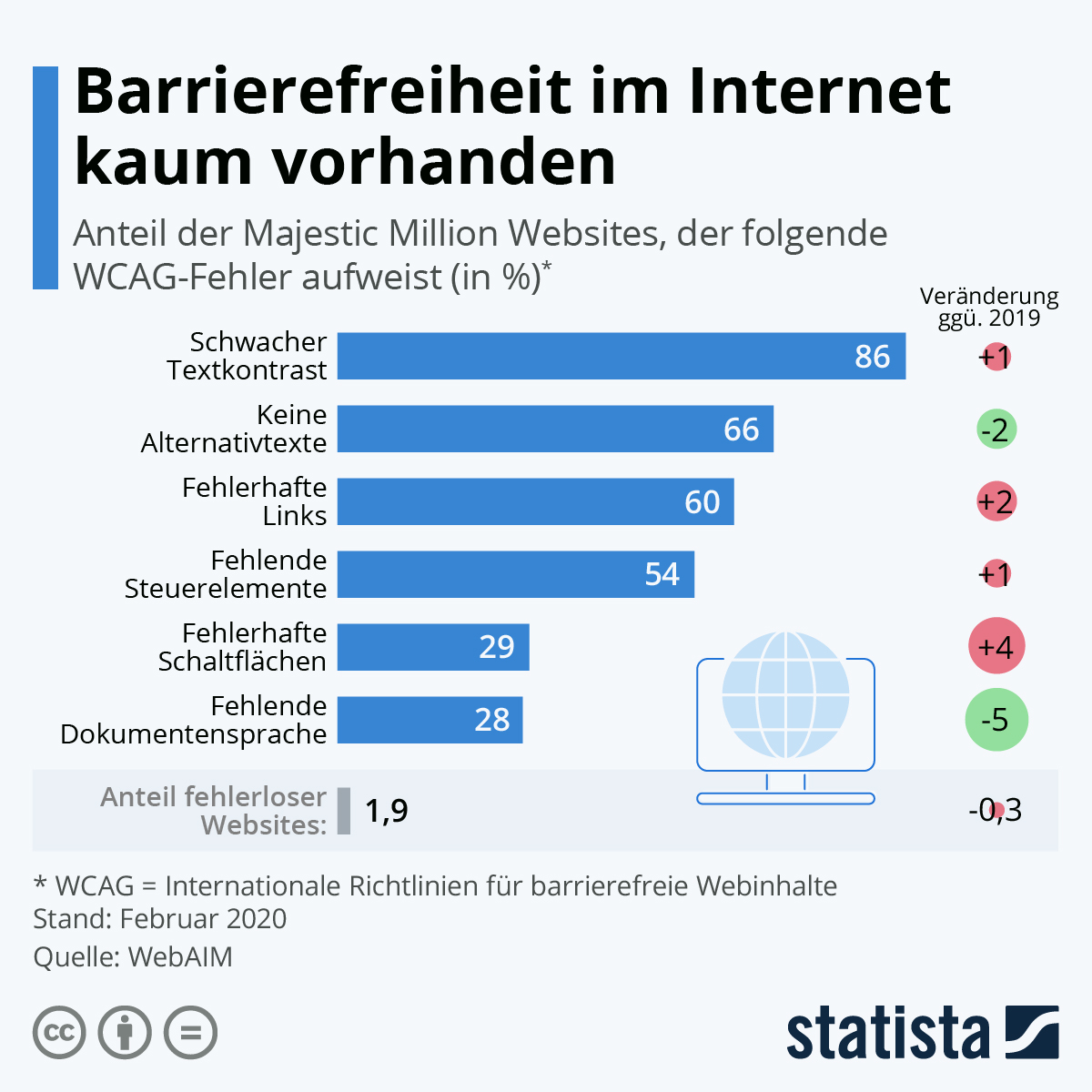The requirements for an inclusive user experience are increasing massively with the new German law for more accessibility.
At the same time, many companies are faced with the challenge of meeting these requirements in the best possible way with their own resources.
UX teams and specialists who not only understand the importance of accessibility, but also know how to implement it effectively, are now in particular demand.
In this article, I take a comprehensive look at the topic of accessibility and how it can be implemented in digital products.
🧠 The most important things in a nutshell
- The Barrierefreiheitsstärkungsgesetz, which is based on the European Accessibility Act (EAA), will come into effect in 2025 and will make it easier for almost one in three Germans to access the web.
- From 2030, newly introduced products and services will be required to be barrier-free; there are transitional periods and special regulations for existing products.
- Companies that already ensure accessibility are gradually gaining a competitive edge and addressing broader target groups.
- Accessibility is best initiated through initial IT, UI and UX accessibility checks and gradually integrated into product development.

Birgit Bärnreuther
Founder & agency manager of Userlutions
Userlutions: We design successful user experiences
Nice to have you here! Our UX agency Userlutions has been helping companies with user-centered design of products and communication measures since 2011. Our team of psychologists, UX researchers and designers provides support in the areas of market research, user research, interface design, user-centered design and business model validation.
Table of contents:
- What is the BFSG?
- These services and products are affected
- The 4 important criteria for an accessible website
- The hidden potential: almost one in three people in Germany is being addressed
- Why is the BFSG important for companies?
- Implement BFSG: We recommend this procedure for websites and stores
Brief overview: What is the BFSG and what should you know?
The Barrierefreiheitsstärkungsgesetz (BFSG) was introduced in July 2021 to transpose the European Accessibility Act (EAA) into national law. It defines accessibility requirements for products and services that are introduced to the market or provided to consumers after June 28, 2025.
It is important to note at this point that the BFSG is still vague in some areas, which means that the exact application to various interactions of websites and apps often remains unclear.
Without legal expertise, it can be difficult to decipher the exact requirements, so in some cases a lawyer may need to be consulted.
I would therefore like to emphasize at this point that my contribution does not constitute a binding statement or legal advice and does not claim to do so.
Instead, I would like to highlight the opportunities and possibilities as well as approaches that we believe will help websites and stores to better approach the topic of accessibility.
Areas of application: These services and products are affected
The BFSG affects manufacturers, dealers and importers of certain products as well as service providers (see table below).
Micro-enterprises with fewer than 10 employees or an annual turnover of less than 2 million euros are partially exempt from the law.
Which consequences are possible?
In the event of non-compliance with the BFSG, market surveillance authorities can take measures such as
- the restriction or prohibition of the provision of the product or service
- the withdrawal or recall of products.
This applies not only to manufacturers, but also to dealers and importers.

This Statista survey of the Majestic Million websites shows that many of the world’s most important and largest websites perform poorly in terms of accessibility.
For example, 86% of the websites surveyed have poor text contrast, 66% have no alternative text, 60% have broken links and 54% have missing controls.
Analyses also repeatedly come to the conclusion that accessibility on the internet is virtually non-existent – so this represents both an opportunity and a risk for many companies.
The 4 important criteria for an accessible website
The Web Content Accessibility Guidelines (WCAG) define the international standards for making websites accessible. A website meets these standards if it complies with the following core principles:
Perceivable
Content must be clearly recognizable, e.g. through clear contrasts. The site should be responsive so that it is optimally displayed on different devices. Information should be made accessible via several sensory channels, e.g. text alternatives for images.
Operable
Both mouse and keyboard users should be able to use all content and functions without any problems. Clear orientation and navigation aids are essential. Users should be given enough time to interact with the site.
Understandable
Content should be presented in easy-to-understand language (or sign language). Support should be offered when entering data in online forms.
Robust
Digital content should be designed so that it can be correctly interpreted by a variety of technologies, such as browsers, screen readers or even personal assistants like Amazon’s Alexa.
The hidden potential: almost one in three people in Germany is being addressed
Let’s approach the BFSG from the perspective of customer centricity, usability and UX – and look at how to gradually implement and consistently ensure the Barrierefreiheitsstärkungsgesetz throughout the company.
Many companies and website operators initially see many new tasks in ensuring accessibility, but at the same time overlook the huge potential that lies right on their doorstep.
When we talk about accessibility, many people immediately think of people with severe disabilities. But the reality is different: The group of people who benefit from an accessible website is far larger than is often assumed.
Let’s look at the figures: 7.6 million severely disabled people and a further 2.8 million people with minor disabilities. In addition, there are over 18 million people over the age of 65 in Germany who may have age-related limitations. That adds up to an impressive 25 million people – almost a third of the German population.
These figures show that accessibility is not only relevant for the “classically disabled”. It is also about people who, for example have poor eyesight or other age-related limitations.
If we optimize our websites or online stores for this huge target group, we also open the door to enormous economic potential.
The advantages are obvious:
- Customer loyalty: An easy-to-use website retains existing customers
- Higher conversion: fewer abandonments mean more completed transactions
- Strong image: Show that you are inclusive and modern
- Competitive advantage: stand out from the competition
- Increased productivity: An accessible design is often also an efficient design
The message is clear: accessibility is not just a legal requirement, but also an opportunity to take the company to the next level.
What is the role of UX in the BFSG?
As we saw in the previous paragraph, accessibility affects far more people than you might think at first glance.
But where do you start when a website has grown over the years or new products and features are regularly developed?
And especially when accessibility becomes mandatory in the entire e-commerce sector from June 28, 2025. This means that many apps and websites must be accessible without any restrictions.
User research offers crucial assistance in order to:
- ensure compliance with the BFSG
- understand and consider the needs of all users
- identify barriers scientifically
- develop sound solutions for dismantling those barriers
- ensure an improvement in the user experience for all people
In a digital world where inclusion and accessibility are becoming increasingly important, accessibility is not just a question of compliance, but also an investment in the future.
We are very fortunate to be able to use our knowledge and expertise from countless UX projects to explore people’s needs in a predictable and structured way. Even target groups that are difficult to reach, such as people with a visual impairment.
We use the following methods, among others, which I would also recommend to other teams to make it easier to ensure accessibility:
- User research: To uncover needs, motivators, pain points and concerns
- UX design & conception: To create resource-saving, user- and conversion-friendly concepts and designs
- UX testing: to test products as easily as possible and derive recommendations and ideas for improving usability and UX
- Ideation & Innovation: these creative processes help to develop, iterate and validate new ideas
From this list, it also follows that companies should involve their own UX departments, UX professionals or external partners in this process in order to approach the topic in as holistic and structured a manner as possible.
This is what our accessibility check looks like
We are convinced that behind every successful digital presence are people who want the best for their users. For us, the path to accessibility therefore begins with a thorough accessibility check by our UX experts.
For this analysis, we use a checklist to ensure accessibility and to gain a comprehensive understanding of how people experience your digital presence.
We look at, among other things:
- Document title: How clear and understandable is the first impression?
- Alternative texts for graphics: Can all images be “seen” even without actually seeing them?
- Headings: Is the content meaningful and logically structured?
- Keyboard operability and keyboard focus: Can any user navigate effortlessly through the application or website
- Forms: Is the input intuitive and error-free?
- Animated content: Are they not disruptive and do they offer added value?
- Videos with subtitles: Can all videos be “heard”, even without sound?
- Reading order: Does the content flow logically and intuitively?
- Contrasts: Is your content clearly visible?
- Zoomability: Can every user see your content in the size that suits them?
Conclusion: We recommend this procedure for websites and stores to implement the BFSG
At a time when digitalization and inclusion go hand in hand, the BFSG is more than just a legal requirement.
The figures speak for themselves: one third of the German population benefits directly from accessible services.
The BFSG is more than an invitation to companies to make their digital presence accessible to everyone and thus not only meet legal requirements, but also reach a wider audience and position themselves positively in the market.
Another advantage of an accessible website is its positive effect on
Search Engine Optimization.
Google and other search engines reward clearly structured websites that fulfill many of the WCAG guidelines. This is because such pages often have clear navigation, meaningful anchor texts and alternative texts for images.
Clean code also often leads to faster loading times. These are all key criteria that influence the ranking in the search results. The result is a win-win situation: companies offer an inclusive user experience and at the same time benefit from better visibility in search results.
A structured process is crucial to ensure accessibility in the digital space. Depending on the type and scope of your own online presence, these processes can also differ from one another.
A possible proposal for such a process at company level:
- Inventory and sensitization
- Check requirements and define mandatory criteria
- Identify target groups and needs
- Analyze your own web presence
- Implementation plan, adaptation and knowledge transfer
With the right approach, supported by expertise in UX and accessibility, companies can not only ensure their compliance, but also develop sustainable competitive advantages. And we hope that as many companies as possible will follow this path successfully.

Share
Share this article